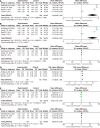Intervention effect of combined resistance and aerobic exercise on type 2 diabetes: A meta-analysis
- PMID: 40697605
- PMCID: PMC12278098
- DOI: 10.4239/wjd.v16.i7.108121
Intervention effect of combined resistance and aerobic exercise on type 2 diabetes: A meta-analysis
Abstract
Background: Type 2 diabetes mellitus (T2DM), a chronic metabolic disease with a high global incidence, has become a serious public health challenge. China has the largest number of T2DM patients worldwide, imposing a significant economic burden on the healthcare system. T2DM is closely associated with insulin resistance, impaired pancreatic B cell function, and disordered glucose and lipid metabolism, which can lead to various complications, reducing patients' quality of life and increasing the risk of disability and death. Thus, finding effective preventive and intervention measures is crucial. Exercise therapy, a key part of diabetes management, has gained attention in recent years, with many studies indicating its benefits for blood glucose control and other aspects in diabetic patients.
Aim: To assess the effectiveness of combined resistance and aerobic exercise interventions on blood glucose control and metabolic indicators in patients with T2DM and to explore their application in diabetes management.
Methods: Systematic searches were conducted using PubMed, EMBASE, Cochrane Library, and Chinese databases for relevant randomized controlled trials (RCTs). The inclusion criteria were participants aged ≥ 18 years with T2DM and the intervention involved combined resistance and aerobic exercise for ≥ 8 weeks. The primary outcome indicators were fasting blood glucose, low-density lipoprotein cholesterol (LDL-C), high-density lipoprotein cholesterol (HDL-C), triglycerides (TG), glycated hemoglobin A1c (HbA1c), and total cholesterol (TC) levels. Data analysis was performed using RevMan software, and the interventional effects were assessed using weighted mean differences or standardized mean differences (SMD).
Results: Six RCTs meeting the inclusion criteria were included, with a total sample size of 366 participants. The meta-analysis results showed that combined resistance and aerobic exercise significantly improved several metabolic indicators in patients with T2DM. Specific results were as follows: (1) For fasting blood glucose, combined exercise was more effective than aerobic exercise alone [SMD = 1.22; 95% confidence interval (95%CI): 0.70, 1.74; P < 0.00001]; (2) LDL-C levels were significantly reduced by the combined intervention (SMD = 1.45; 95%CI: 1.18-1.72; P < 0.00001); (3) The combined intervention significantly increased HDL-C levels (SMD = 1.42; 95%CI: 0.98-1.87; P < 0.00001); (4) The combined intervention significantly reduced TG levels (SMD = 1.12; 95%CI: 0.85-1.39; P < 0.00001; (5) No statistically significant difference was observed in HbA1c between the combined and the aerobic exercise group (SMD = -0.03; 95%CI: -1.09 to 1.04; P < 0.00001); and (6) The combined exercise intervention group significantly reduced TC levels (SMD = 2.66; 95%CI: 1.93-3.38; P < 0.00001). The subgroup analysis results suggest that the effect of exercise interventions may be influenced by various factors, including the patient's age, baseline blood glucose levels, and exercise intensity.
Conclusion: Combined resistance and aerobic exercise intervention significantly improved fasting blood glucose, LDL-C, HDL-C, TG, and TC levels in patients with T2DM, especially in terms of blood glucose control and cardiovascular risk, demonstrating better outcomes than aerobic exercise alone.
Keywords: Aerobic exercise; Blood glucose control; Combined resistance exercise; Meta-analysis; Metabolic indicators; Type 2 diabetes.
©The Author(s) 2025. Published by Baishideng Publishing Group Inc. All rights reserved.
Conflict of interest statement
Conflict-of-interest statement: The authors declare that they have no competing interests.
Figures




Similar articles
-
Physical exercise training interventions for children and young adults during and after treatment for childhood cancer.Cochrane Database Syst Rev. 2016 Mar 31;3(3):CD008796. doi: 10.1002/14651858.CD008796.pub3. Cochrane Database Syst Rev. 2016. PMID: 27030386 Free PMC article.
-
Personalised care planning for adults with chronic or long-term health conditions.Cochrane Database Syst Rev. 2015 Mar 3;2015(3):CD010523. doi: 10.1002/14651858.CD010523.pub2. Cochrane Database Syst Rev. 2015. PMID: 25733495 Free PMC article.
-
Insulin secretagogues for prevention or delay of type 2 diabetes mellitus and its associated complications in persons at increased risk for the development of type 2 diabetes mellitus.Cochrane Database Syst Rev. 2016 Oct 17;10(10):CD012151. doi: 10.1002/14651858.CD012151.pub2. Cochrane Database Syst Rev. 2016. PMID: 27749986 Free PMC article.
-
Dipeptidyl-peptidase (DPP)-4 inhibitors and glucagon-like peptide (GLP)-1 analogues for prevention or delay of type 2 diabetes mellitus and its associated complications in people at increased risk for the development of type 2 diabetes mellitus.Cochrane Database Syst Rev. 2017 May 10;5(5):CD012204. doi: 10.1002/14651858.CD012204.pub2. Cochrane Database Syst Rev. 2017. PMID: 28489279 Free PMC article.
-
Diet, physical activity or both for prevention or delay of type 2 diabetes mellitus and its associated complications in people at increased risk of developing type 2 diabetes mellitus.Cochrane Database Syst Rev. 2017 Dec 4;12(12):CD003054. doi: 10.1002/14651858.CD003054.pub4. Cochrane Database Syst Rev. 2017. PMID: 29205264 Free PMC article.
References
-
- Awoke T, Kiflu DA, Tadesse DA. The Effect of Aerobic and Combined, Aerobic-anaerobicexercise on Obese Diabetic Patients. 2024 Preprint.
-
- Kaikhosro Doulatyari P, Ghahramani M, Mozaffari K. Investigating the Effect of Aerobic and Resistance Training on Insulin Resistance and Some Cardiovascular Disease Risk Factors in Type 2 Diabetes Mellitus Patients: A Systematic Review. J Clin Res Paramed Sci. 2023;12:e134510.
LinkOut - more resources
Full Text Sources
Miscellaneous

